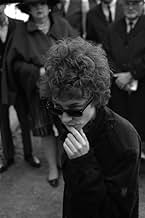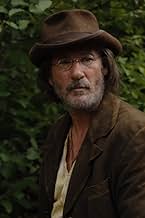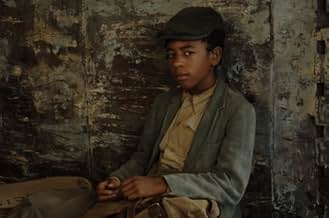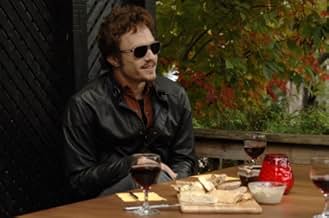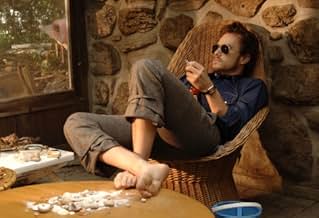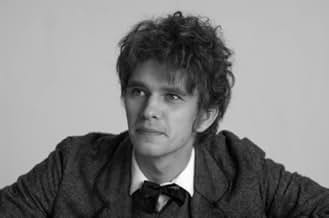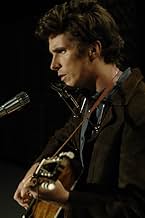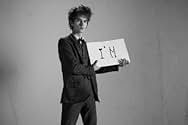Riflessioni sulla vita di Bob Dylan, dove sei personaggi incarnano un aspetto diverso della vita e del lavoro del musicista.Riflessioni sulla vita di Bob Dylan, dove sei personaggi incarnano un aspetto diverso della vita e del lavoro del musicista.Riflessioni sulla vita di Bob Dylan, dove sei personaggi incarnano un aspetto diverso della vita e del lavoro del musicista.
- Candidato a 1 Oscar
- 29 vittorie e 49 candidature totali
Roc Lafortune
- Hobo Moe
- (as Roc LaFortune)
Brian R.C. Wilmes
- Circus Man
- (as Brian RC Wilmes)
Recensioni in evidenza
Unless you know something about the subject of this biography, you're bound to be confused by "I'm Not There". It is "inspired by the music & many lives of Bob Dylan." For the unenlightened, Mr. Dylan was famous, long ago ("for playing electric violins on desolation row"). The film, by writer/director Todd Haynes is excellent, but inaccessible. And, strangely, if you know anything about the subject, you're going to learn approximately nothing knew. To help navigate, there were four main Dylans
FIRST and famed-mostly, Dylan was a "Rock Star". This period is played out by Cate Blanchett as "Jude Quinn". This character sports a fictitious name, but like much of the movie, comes (not from McCartney's "Jude" but) obviously from Dylan's oeuvre - the Christian "Jude" and "Quinn the Eskimo". This Dylan has the clearest Beginning and End points of any. He was "born" when startling his folk audience by "going electric" (guitar) and "dies" in a motorcycle accident at the peak of his fame.
SECOND most famous, and highly influential, Dylan was the "Folk Singer" replaced by the above. Here, it's Christian Bale as "Jack Rollins". This Dylan was quite popular on his own, but was much "covered" by other folk artists and rock bands. During this time, Dylan was more like a very big cult, and his songs were more widely heard when other people made hit records from them. The songs were more Political (protest) during this time, getting vague later (with exceptions, like "Hurricane").
THIRD time around for Dylan was his "Cowboy" persona, essayed herein by Richard Gere and named "Billy the Kid" after the outlaw anti-hero Dylan play-acted. This was the Dylan emerging after the motorcycle accident. Dylan left a bunch of unreleased tracks (known as "The Basement Tapes") and "reinvented" himself as a more countrified mellow rocker (listen to "Lay Lady Lay"). Here, the "stages" of Dylan's art become more blurred as he no longer commanded the attention he did earlier.
FOURTH biggest change, after a long run without defining boundaries, was the "Born Again" or "Christian" Dylan. This startled some people, but (as the film points out) it shouldn't have been unexpected. In fact, the "Fame"/"Drugs"/"Jesus" continuum is very common among music stars, as anyone watching MTV's 1990s biographies could plainly see. For this film, Mr. Bale (uniquely) plays two Dylan incarnations, revising his earlier "Folk Singer" character "Jack Rollins" to become "Pastor John".
BUT, that's not all. There are three less public parts of the quadraphonic Dylan covered by Mr. Haynes
FIRST is Dylan's mysterious boyhood masquerade as "Woody Guthrie" played by Marcus Carl Franklin. He is the kid on the train, sporting the Fascist-Killing-Guitar-in-the-West. Of course, Woody Guthrie was a real person, and he had a tremendous influence on Dylan. While cute and well done, this section is not revelatory, which could be why the film project had "the real" Bob Dylan's blessing. The real Dylan, who appears briefly near the end, did not appreciate biographers peeking into his personal history.
SECOND is Dylan "The Poet" named "Arthur Rimbaud" and played by Ben Whishaw. Like the above, but more of a conglomerate, the character is a real French poet named Arthur Rimbaud who influenced Dylan (and many other rock stars). The Dylans are presented in sort of an overlapping chronological order - which may not make sense to the uninitiated - but this one is used more like a muse for the others, accentuating Dylan's reputation as a true "Tarantula" of a Poet, even without the music.
THIRD and perhaps most esoteric is Dylan "The Actor" played by Heath Ledger as "Robbie Clark". Dylan did do some movies. Mortals do not forgive. Even an epic focusing in his relationship with a certain sad-eyed of the lowlands. Rather than show Dylan acting in a movie, this "Actor" section perversely shows the more camera-shy Dylan. It seems highly fictitious, but you've got to appreciate "Dylan" telling what looks like "Patti Smith", "chicks can never be poets." (!) And, "I Want You" is a terrific vignette.
In sum, "I'm Not There" is an excellent film for obvious believers, with minus zero insight into its subject. Bobby Zimmerman could hardly disapprove. By the way, the fact that the vinyl "Stuck Inside of Mobile with the " was amusingly continued in the "Blonde on Blonde" gate-fold jacket as " Memphis Blues Again" is no excuse to edit the song. And, changing the lyric, "Here is your 'throat' back, thanks for the loan..." to "Here is your 'mouth' back, thanks for the loan..." really sucks. Moreover, it's sacrilege.
******* I'm Not There (9/3/07) Todd Haynes ~ Christian Bale, Cate Blanchett, Heath Ledger, Richard Gere
FIRST and famed-mostly, Dylan was a "Rock Star". This period is played out by Cate Blanchett as "Jude Quinn". This character sports a fictitious name, but like much of the movie, comes (not from McCartney's "Jude" but) obviously from Dylan's oeuvre - the Christian "Jude" and "Quinn the Eskimo". This Dylan has the clearest Beginning and End points of any. He was "born" when startling his folk audience by "going electric" (guitar) and "dies" in a motorcycle accident at the peak of his fame.
SECOND most famous, and highly influential, Dylan was the "Folk Singer" replaced by the above. Here, it's Christian Bale as "Jack Rollins". This Dylan was quite popular on his own, but was much "covered" by other folk artists and rock bands. During this time, Dylan was more like a very big cult, and his songs were more widely heard when other people made hit records from them. The songs were more Political (protest) during this time, getting vague later (with exceptions, like "Hurricane").
THIRD time around for Dylan was his "Cowboy" persona, essayed herein by Richard Gere and named "Billy the Kid" after the outlaw anti-hero Dylan play-acted. This was the Dylan emerging after the motorcycle accident. Dylan left a bunch of unreleased tracks (known as "The Basement Tapes") and "reinvented" himself as a more countrified mellow rocker (listen to "Lay Lady Lay"). Here, the "stages" of Dylan's art become more blurred as he no longer commanded the attention he did earlier.
FOURTH biggest change, after a long run without defining boundaries, was the "Born Again" or "Christian" Dylan. This startled some people, but (as the film points out) it shouldn't have been unexpected. In fact, the "Fame"/"Drugs"/"Jesus" continuum is very common among music stars, as anyone watching MTV's 1990s biographies could plainly see. For this film, Mr. Bale (uniquely) plays two Dylan incarnations, revising his earlier "Folk Singer" character "Jack Rollins" to become "Pastor John".
BUT, that's not all. There are three less public parts of the quadraphonic Dylan covered by Mr. Haynes
FIRST is Dylan's mysterious boyhood masquerade as "Woody Guthrie" played by Marcus Carl Franklin. He is the kid on the train, sporting the Fascist-Killing-Guitar-in-the-West. Of course, Woody Guthrie was a real person, and he had a tremendous influence on Dylan. While cute and well done, this section is not revelatory, which could be why the film project had "the real" Bob Dylan's blessing. The real Dylan, who appears briefly near the end, did not appreciate biographers peeking into his personal history.
SECOND is Dylan "The Poet" named "Arthur Rimbaud" and played by Ben Whishaw. Like the above, but more of a conglomerate, the character is a real French poet named Arthur Rimbaud who influenced Dylan (and many other rock stars). The Dylans are presented in sort of an overlapping chronological order - which may not make sense to the uninitiated - but this one is used more like a muse for the others, accentuating Dylan's reputation as a true "Tarantula" of a Poet, even without the music.
THIRD and perhaps most esoteric is Dylan "The Actor" played by Heath Ledger as "Robbie Clark". Dylan did do some movies. Mortals do not forgive. Even an epic focusing in his relationship with a certain sad-eyed of the lowlands. Rather than show Dylan acting in a movie, this "Actor" section perversely shows the more camera-shy Dylan. It seems highly fictitious, but you've got to appreciate "Dylan" telling what looks like "Patti Smith", "chicks can never be poets." (!) And, "I Want You" is a terrific vignette.
In sum, "I'm Not There" is an excellent film for obvious believers, with minus zero insight into its subject. Bobby Zimmerman could hardly disapprove. By the way, the fact that the vinyl "Stuck Inside of Mobile with the " was amusingly continued in the "Blonde on Blonde" gate-fold jacket as " Memphis Blues Again" is no excuse to edit the song. And, changing the lyric, "Here is your 'throat' back, thanks for the loan..." to "Here is your 'mouth' back, thanks for the loan..." really sucks. Moreover, it's sacrilege.
******* I'm Not There (9/3/07) Todd Haynes ~ Christian Bale, Cate Blanchett, Heath Ledger, Richard Gere
To appreciate I’m Not There., you need to fully buy into its somewhat-implausible premise; in it, six actors represent various aspects of Bob Dylan throughout his many decades in the limelight. If you buy into this premise, then this is a unique, thoughtful perspective of an almost-unknowable individual, a man who famously played things close to the vest, a man who shunned introspection. But if you don’t immediately buy into this premise, then the movie just feels like a long experiment that isn’t entirely successful, and in the end you don’t feel you know much more about the man, the myth, the legend than you knew going in. Which might be the point, who’s to say? And that’s sort of where I land on the whole I’m Not There. issue.
Here’s one big problem right off the bat. The six various characters, each representing part of Dylan, have different names. Some of them are named after real-life people, like Woody Guthrie and Arthur Rimbaud. Some have fictitious names, like Jude Quinn (an amalgam of Jude from “Hey Jude” and Dylan’s own “The Mighty Quinn”), Jack Rollins, and Robbie Clark - the latter being an actor playing one of the aspects in a movie. And then it gets confusing.
The first gimmick for this movie is that each aspect is played by an actor you wouldn’t expect to see playing Dylan. Okay, maybe not all of them, but some of them. Cate Blanchett is one. She’s female, in case you were unsure, and she is by far the best Dylan in the movie. She plays Jude, the latter-day, peeved-at-everyone Dylan. Another is Marcus Carl Franklin, who plays “Woody Guthrie” - here, a young version of Dylan, riding the rails across the Midwest. Franklin is African American. Then there’s Heath Ledger and Christian Bale, who are Australian (as is Blanchett) and Welsh, respectively. The problem with those, though, is that the only difference between them and the real Dylan is Dylan’s particular linguistic tendencies, so you wind up with just some guys acting Dylanesque. You know, the perpetual cigarette dangling precariously, the hat, the whole nine yards.
It would have been more effective, for me, if each of the aspects was played by completely different looking people - because in order for them to be identifiable as Dylan, they would have to sound like him. Otherwise you’re left with some folk-singing iconoclast who’s rebelling against everyone, and you don’t know why. So there’s one issue. And that would have been a clever, but not too-clever, way for each supposed aspect or time period to be represented. Even if two aspects were on the screen simultaneously, big deal - at least we could tell who was who.
But added to this gimmick is the fact that some non-Dylan characters - and some situations - are based on real-life people, like Allen Ginsburg, and retain their counterparts’ names, and others are clearly supposed to be real people but have … different names. And some situations definitely did occur (such as Dylan’s getting booed at the Newport festival, a huge turning point for him), but did all of them? Were any of them made up to highlight that particular aspect of his personality? One of the characters is Arthur Rimbaud. No, not the poet, he just has that name. Anyway, the entirety of his screen time is spent giving testimony or something to officials (or a jury, I’m not sure). And his speeches are of the deep philosophical sort, the kind that Dylan was apparently fond of - ways to get into people’s minds, but I’m not sure what the soliloquies add in terms of exposition and revelation.
Then there’s also Richard Gere, who plays Billy the Kid, another “aspect” of Dylan. Apparently here Billy is mythologized as this hiding loner at the end of his career, just sort of like Dylan, only Dylan’s not even now at the end of his career, unless he keels over tomorrow, or something. Gere’s good, and I don’t say that often, but I think the aspect, such as it is, is too abstract and unreadable to be worthwhile.
The intermittent narrator (Kris Kristofferson) is marginally helpful; perhaps he could have been used to tie all these aspects together. Instead we get two hours of ego feeding and idol worship. To me, though, it felt more like idle worship than anything else, a waste of time even if you’re willing to grasp whatever deep insights the film pretends to offer to you.
Here’s one big problem right off the bat. The six various characters, each representing part of Dylan, have different names. Some of them are named after real-life people, like Woody Guthrie and Arthur Rimbaud. Some have fictitious names, like Jude Quinn (an amalgam of Jude from “Hey Jude” and Dylan’s own “The Mighty Quinn”), Jack Rollins, and Robbie Clark - the latter being an actor playing one of the aspects in a movie. And then it gets confusing.
The first gimmick for this movie is that each aspect is played by an actor you wouldn’t expect to see playing Dylan. Okay, maybe not all of them, but some of them. Cate Blanchett is one. She’s female, in case you were unsure, and she is by far the best Dylan in the movie. She plays Jude, the latter-day, peeved-at-everyone Dylan. Another is Marcus Carl Franklin, who plays “Woody Guthrie” - here, a young version of Dylan, riding the rails across the Midwest. Franklin is African American. Then there’s Heath Ledger and Christian Bale, who are Australian (as is Blanchett) and Welsh, respectively. The problem with those, though, is that the only difference between them and the real Dylan is Dylan’s particular linguistic tendencies, so you wind up with just some guys acting Dylanesque. You know, the perpetual cigarette dangling precariously, the hat, the whole nine yards.
It would have been more effective, for me, if each of the aspects was played by completely different looking people - because in order for them to be identifiable as Dylan, they would have to sound like him. Otherwise you’re left with some folk-singing iconoclast who’s rebelling against everyone, and you don’t know why. So there’s one issue. And that would have been a clever, but not too-clever, way for each supposed aspect or time period to be represented. Even if two aspects were on the screen simultaneously, big deal - at least we could tell who was who.
But added to this gimmick is the fact that some non-Dylan characters - and some situations - are based on real-life people, like Allen Ginsburg, and retain their counterparts’ names, and others are clearly supposed to be real people but have … different names. And some situations definitely did occur (such as Dylan’s getting booed at the Newport festival, a huge turning point for him), but did all of them? Were any of them made up to highlight that particular aspect of his personality? One of the characters is Arthur Rimbaud. No, not the poet, he just has that name. Anyway, the entirety of his screen time is spent giving testimony or something to officials (or a jury, I’m not sure). And his speeches are of the deep philosophical sort, the kind that Dylan was apparently fond of - ways to get into people’s minds, but I’m not sure what the soliloquies add in terms of exposition and revelation.
Then there’s also Richard Gere, who plays Billy the Kid, another “aspect” of Dylan. Apparently here Billy is mythologized as this hiding loner at the end of his career, just sort of like Dylan, only Dylan’s not even now at the end of his career, unless he keels over tomorrow, or something. Gere’s good, and I don’t say that often, but I think the aspect, such as it is, is too abstract and unreadable to be worthwhile.
The intermittent narrator (Kris Kristofferson) is marginally helpful; perhaps he could have been used to tie all these aspects together. Instead we get two hours of ego feeding and idol worship. To me, though, it felt more like idle worship than anything else, a waste of time even if you’re willing to grasp whatever deep insights the film pretends to offer to you.
While not the biggest fan of Bob Dylan, a lot of his songs are great (especially in the lyric writing) and he has an immediately distinctive voice, he is a musician who is appreciated highly by me and it is easy to recognise his importance.
'I'm Not There', regardless of having a talented big name cast, generally didn't do much for me. It is interesting sure, with a unique and quite bold concept, but it doesn't come off completely successfully. There are things to appreciate but it is understandable why some may dislike it, it's pretty divisive as a film.
Starting with 'I'm Not There's' good points, it is beautifully and atmospherically made and adeptly directed by Todd Haynes. Dylan's music is just great and beautifully incorporated and interpreted.
A big strength is the cast, a vast majority of them giving strong performances. Cate Blanchett, barely recognisable, is particularly excellent, with Christian Bale, Marcus Carl Franklin and Heath Ledger more than up to her level. There are some entertaining secondary performances from Charlotte Gainsbourg, David Cross and Julianne Moore. Dylan is remarkably multi-faceted, where we see him as a rebellious poet, a protest singer, a drug-addled rock star, a matinée idol with marriage woes, and a born-again Christian.
Not everything works. The concept does intrigue, but the time shifts do feel muddled and confusing. 'I'm Not There' is overlong with it going longer than necessary and the pacing rambles making the film drag.
While most of the cast are great, Richard Gere and his story are tacked on and uninteresting and Ben Whishaw is a little dull. The script could have been tighter and more cohesive.
Overall, not awful but underwhelming and easy to see why it's a divisive film. Bob Dylan deserved better than this. 5/10 Bethany Cox
'I'm Not There', regardless of having a talented big name cast, generally didn't do much for me. It is interesting sure, with a unique and quite bold concept, but it doesn't come off completely successfully. There are things to appreciate but it is understandable why some may dislike it, it's pretty divisive as a film.
Starting with 'I'm Not There's' good points, it is beautifully and atmospherically made and adeptly directed by Todd Haynes. Dylan's music is just great and beautifully incorporated and interpreted.
A big strength is the cast, a vast majority of them giving strong performances. Cate Blanchett, barely recognisable, is particularly excellent, with Christian Bale, Marcus Carl Franklin and Heath Ledger more than up to her level. There are some entertaining secondary performances from Charlotte Gainsbourg, David Cross and Julianne Moore. Dylan is remarkably multi-faceted, where we see him as a rebellious poet, a protest singer, a drug-addled rock star, a matinée idol with marriage woes, and a born-again Christian.
Not everything works. The concept does intrigue, but the time shifts do feel muddled and confusing. 'I'm Not There' is overlong with it going longer than necessary and the pacing rambles making the film drag.
While most of the cast are great, Richard Gere and his story are tacked on and uninteresting and Ben Whishaw is a little dull. The script could have been tighter and more cohesive.
Overall, not awful but underwhelming and easy to see why it's a divisive film. Bob Dylan deserved better than this. 5/10 Bethany Cox
This movie can be difficult to follow if you are not familiar with Bob Dylan, but it is in fact a carefully and lovingly crafted tribute, that aims to reflect the essence of the artist's work and life. It is a fun take on its subject, though in order to be fully appreciated, one has to know what is being explored. Otherwise, it may seem a tedious watch, but perhaps that is appropriate as in order to fully appreciate Bob Dylan, one has to pay attention, and then it becomes quite rewarding. The shape-shifting nature of Bob Dylan has been portrayed, quite fittingly, by several actors of various backgrounds, ages, sexes and races - in that respect, it is as original and unexpected as its subject. All in all, an interesting, artistic and original but perhaps somewhat inaccessible - to an uninitiated viewer - tribute to one of the greatest artistic geniuses Americana has ever reared.
Haynes' adventurous biopic of Bob Dylan, which uses six actors of both sexes and several races ranging in ages from 11 to 50, is both exhausting and fun to watch. It's also hard to describe. But let's start with those six and the characters or facets they portray. Arthur (Ben Whishaw) is the Dylan who incarnated Rimbaud and serves as a kind of narrator whom we see smoking and giving ironic answers to some kind of inquisition sporadically throughout the film. Woody (the wonderful young Marcus Carl Franklin, an amazing a singer and actor) is a precocious rail-hopper with a guitar (labeled like the real Woody's, THIS MACHINE KILLS FASCISTS) and tall tales that start with his claim that he's Woody Guthrie. Woody's scenes show him rescued by a black family and a white family and performing with country black musicals. He represents the early shape-shifting Dylan in search of an identity and telling a lot of lies along the way.
Jack (Christian Bale) is the Dylan who became a hit in Greenwich Village and went into the South and sang "The Ballad of Hattie Carroll" and other protest "folk songs,"-the high-profile "political" Dylan who spearheaded a movement and became famous with his brilliant early LP's. But Jack doesn't want to be typecast and "betrays" his adoring public and his lover and folksinging champion Alice (Julianne Moore), a Joan Baez stand-in seen in later "interviews." Jack disappears and his place is taken by Robbie (Heath Ledger), a young actor in New York who becomes famous for starring in a 1965 film depicting the vanished Jack. Robbie meets Claire (Charlotte Gainsbourg) in a Village coffee shop and falls in love, and a turbulent ten-year marriage follows, winding up painfully at the time of the Vietnam War's end.
If Jack represents the cast-off early style and Robbie represents Dylan's family life, Jude (Cate Blanchett) is Dylan the artist, quintessentially as seen in the mid-to-late Sixties when he toured England (an event notably chronicled by two Leacock-Pennebaker documentaries)-and shocked his audiences, some of whose members felt betrayed and shouted "Judas!", when he shifted from solo guitar and harmonica to more personal songs with loud rock accompaniment. Jude's segments are partly borrowed from Pennebaker, but largely consist of gorgeous black and white scenes deliberately and "churlishly" (Haynes' word) imitative of Fellini's 8 ½.
Jude's new style is admired by Allen Ginsberg (David Cross) and underground groupie Coco Rivington (Michelle Williams) and he becomes internationally famous. But he continues to be misunderstood by the protest music old guard and conventional journalists like the British TV host Mr. Jones (Bruce Greenwood)-who's incorporated into a music video for Highway 61 Revisited's "Ballad of a Thin Man": ". . .something is happening here /And you don't know what it is, do you, Mister Jones." . .
Jude and Arthur articulate the early Dylan's challenging, ironic stance to the public, but Jude is exhausted on tour and his nihilism leads him to an existential crisis.
He's reborn symbolically in Pastor John (Christian Bale again), who's moved to Stockton twenty years later and become a born-again preacher, singing his own gospel songs. Finally the last version of Dylan appears in Billy (Richard Gere), in full retreat from the world till threats to destroy his town of Riddle cause him to enter public life again. This sequence evokes a Sixties historical western in which Pat Garrett (Bruce Greenwood) is a character.
This is only the barest outline of the two-and-a-quarter-hour film, in which various "Dylan's" are woven in and out. Maybe the reason why I found Woody's sequences delightful and Billy's colorful but wearying has to do with the latter's coming two hours later. But Gere and his sequences evoke Dylan less well and are puzzling to interpret. Blanchett's in contrast are, of course, the most conventionally straightforward. She's the only one who successfully mimics the physical appearance and the speaking voice of the artist (unless Whishaw does a better job with the voice). But Blanchett's mimicry is intentionally undercut (and the biopic conventionality of films like Ray avoided) by having Jude be played by a woman-which was planned by Haynes in his screenplay before he even chose his actor.
The method Haynes has chosen avoids cliché. This is still a biopic, but it's a sophisticated one; and the fractured portrait is well justified by the nature of its subject. Dylan has always been a shape-shifter; some of his permutations were left out, such as the period of the orthodox Jew and JDL supporter. But it's intelligent to see Dylan the man, the husband, the artist, the political being, and the religious being as completely separate entities because no simple biopic sequence can really dramatize the complexity of such an artist and such a protean existence. Haynes' film makes you think about biography itself, as well as giving imaginative shape to aspects of Bob Dylan no non-fiction account can really provide.
Maybe it's the daringly experimental methodology that led Dylan himself, approached through his eldest son Jesse, to grant Haynes both the musical rights and the biographical rights. Haynes has chosen a multifaceted and original way of using Dylan's songs. Only Franklin actually performs them with his own voice. Otherwise the soundtrack mixes original Dylan recordings with existing covers, new ones by people as widely various as Ritche Havens, Iggy Pop, John Doe and Sonic Youth, and other music, including, appropriately for the 8 ½- esque sequences, Nino Rota. There is a voice-over narration by Kris Kristofferson. Haynes worked on the screenplay for years, and then collaborated with Oren Moverman.
Not for mainstream audiences or be prime Oscar bait, but a challenging, fun watch.
Shown in the press screenings of the New York Film Festival at Lincoln Center 2007. Haynes was present for a Q&A afterward with J. Hoberman of the Village Voice, which revealed that the director is an intelligent and articulate man who knows his Dylan.
Jack (Christian Bale) is the Dylan who became a hit in Greenwich Village and went into the South and sang "The Ballad of Hattie Carroll" and other protest "folk songs,"-the high-profile "political" Dylan who spearheaded a movement and became famous with his brilliant early LP's. But Jack doesn't want to be typecast and "betrays" his adoring public and his lover and folksinging champion Alice (Julianne Moore), a Joan Baez stand-in seen in later "interviews." Jack disappears and his place is taken by Robbie (Heath Ledger), a young actor in New York who becomes famous for starring in a 1965 film depicting the vanished Jack. Robbie meets Claire (Charlotte Gainsbourg) in a Village coffee shop and falls in love, and a turbulent ten-year marriage follows, winding up painfully at the time of the Vietnam War's end.
If Jack represents the cast-off early style and Robbie represents Dylan's family life, Jude (Cate Blanchett) is Dylan the artist, quintessentially as seen in the mid-to-late Sixties when he toured England (an event notably chronicled by two Leacock-Pennebaker documentaries)-and shocked his audiences, some of whose members felt betrayed and shouted "Judas!", when he shifted from solo guitar and harmonica to more personal songs with loud rock accompaniment. Jude's segments are partly borrowed from Pennebaker, but largely consist of gorgeous black and white scenes deliberately and "churlishly" (Haynes' word) imitative of Fellini's 8 ½.
Jude's new style is admired by Allen Ginsberg (David Cross) and underground groupie Coco Rivington (Michelle Williams) and he becomes internationally famous. But he continues to be misunderstood by the protest music old guard and conventional journalists like the British TV host Mr. Jones (Bruce Greenwood)-who's incorporated into a music video for Highway 61 Revisited's "Ballad of a Thin Man": ". . .something is happening here /And you don't know what it is, do you, Mister Jones." . .
Jude and Arthur articulate the early Dylan's challenging, ironic stance to the public, but Jude is exhausted on tour and his nihilism leads him to an existential crisis.
He's reborn symbolically in Pastor John (Christian Bale again), who's moved to Stockton twenty years later and become a born-again preacher, singing his own gospel songs. Finally the last version of Dylan appears in Billy (Richard Gere), in full retreat from the world till threats to destroy his town of Riddle cause him to enter public life again. This sequence evokes a Sixties historical western in which Pat Garrett (Bruce Greenwood) is a character.
This is only the barest outline of the two-and-a-quarter-hour film, in which various "Dylan's" are woven in and out. Maybe the reason why I found Woody's sequences delightful and Billy's colorful but wearying has to do with the latter's coming two hours later. But Gere and his sequences evoke Dylan less well and are puzzling to interpret. Blanchett's in contrast are, of course, the most conventionally straightforward. She's the only one who successfully mimics the physical appearance and the speaking voice of the artist (unless Whishaw does a better job with the voice). But Blanchett's mimicry is intentionally undercut (and the biopic conventionality of films like Ray avoided) by having Jude be played by a woman-which was planned by Haynes in his screenplay before he even chose his actor.
The method Haynes has chosen avoids cliché. This is still a biopic, but it's a sophisticated one; and the fractured portrait is well justified by the nature of its subject. Dylan has always been a shape-shifter; some of his permutations were left out, such as the period of the orthodox Jew and JDL supporter. But it's intelligent to see Dylan the man, the husband, the artist, the political being, and the religious being as completely separate entities because no simple biopic sequence can really dramatize the complexity of such an artist and such a protean existence. Haynes' film makes you think about biography itself, as well as giving imaginative shape to aspects of Bob Dylan no non-fiction account can really provide.
Maybe it's the daringly experimental methodology that led Dylan himself, approached through his eldest son Jesse, to grant Haynes both the musical rights and the biographical rights. Haynes has chosen a multifaceted and original way of using Dylan's songs. Only Franklin actually performs them with his own voice. Otherwise the soundtrack mixes original Dylan recordings with existing covers, new ones by people as widely various as Ritche Havens, Iggy Pop, John Doe and Sonic Youth, and other music, including, appropriately for the 8 ½- esque sequences, Nino Rota. There is a voice-over narration by Kris Kristofferson. Haynes worked on the screenplay for years, and then collaborated with Oren Moverman.
Not for mainstream audiences or be prime Oscar bait, but a challenging, fun watch.
Shown in the press screenings of the New York Film Festival at Lincoln Center 2007. Haynes was present for a Q&A afterward with J. Hoberman of the Village Voice, which revealed that the director is an intelligent and articulate man who knows his Dylan.
Lo sapevi?
- QuizTodd Haynes needed to get approval from Bob Dylan to use his music, since (unlike in his Velvet Goldmine (1998) where David Bowie did not give his permission for his music) he felt the film would not work without it. At the encouragement of Dylan's manager, Haynes wrote a one-page summary of his concept and the characters, which Dylan approved. It took another 6 years to get the film made due to funding difficulties.
- BlooperWhen Woody's character is first seen he is running towards a train going North but when he is sitting on the train, it is noticeably going South.
- Citazioni
Billy the Kid: People are always talking about freedom. Freedom to live a certain way, without being kicked around. Course the more you live a certain way, the less it feel like freedom. Me, uhm, I can change during the course of a day. I wake and I'm one person, when I go to sleep I know for certain I'm somebody else. I don't know who I am most of the time.
- Curiosità sui creditiThe way the title appears on the screen at the opening would read: I he I'm her not her not here. I'm not there" (period included).
- Colonne sonoreGoin' to Acapulco
Performed by Jim James and Calexico
Written by Bob Dylan
Published by Dwarf Music (SESAC)
Produced by Joey Burns
Jim James appears courtesy of ATO Records
Calexico appears courtesy of Quarterstick Records
I più visti
Accedi per valutare e creare un elenco di titoli salvati per ottenere consigli personalizzati
Dettagli
- Data di uscita
- Paesi di origine
- Siti ufficiali
- Lingua
- Celebre anche come
- Mi historia sin mi
- Luoghi delle riprese
- Aziende produttrici
- Vedi altri crediti dell’azienda su IMDbPro
Botteghino
- Budget
- 20.000.000 USD (previsto)
- Lordo Stati Uniti e Canada
- 4.017.609 USD
- Fine settimana di apertura Stati Uniti e Canada
- 730.819 USD
- 25 nov 2007
- Lordo in tutto il mondo
- 11.792.542 USD
- Tempo di esecuzione2 ore 15 minuti
- Colore
- Mix di suoni
- Proporzioni
- 2.35 : 1
Contribuisci a questa pagina
Suggerisci una modifica o aggiungi i contenuti mancanti





